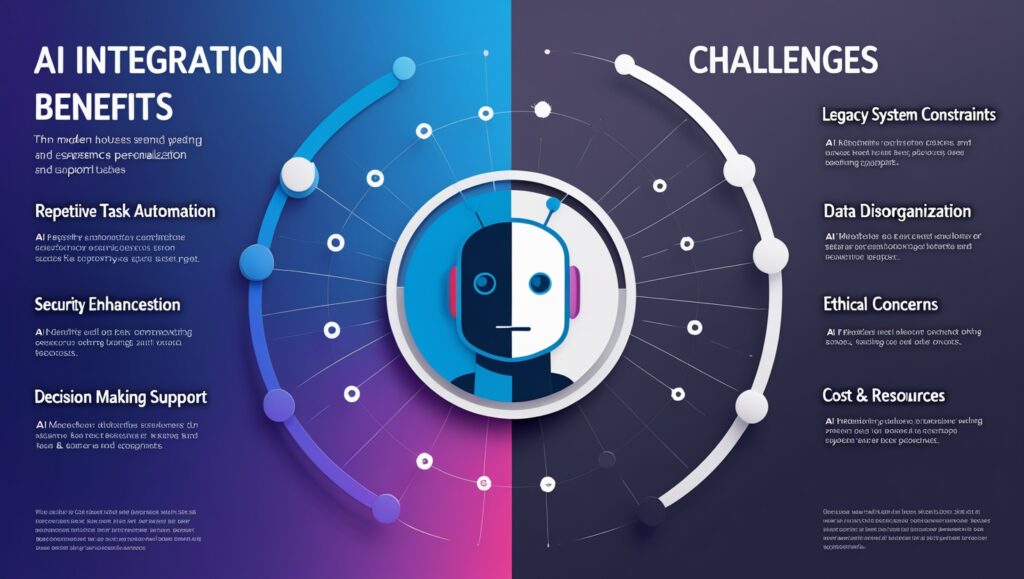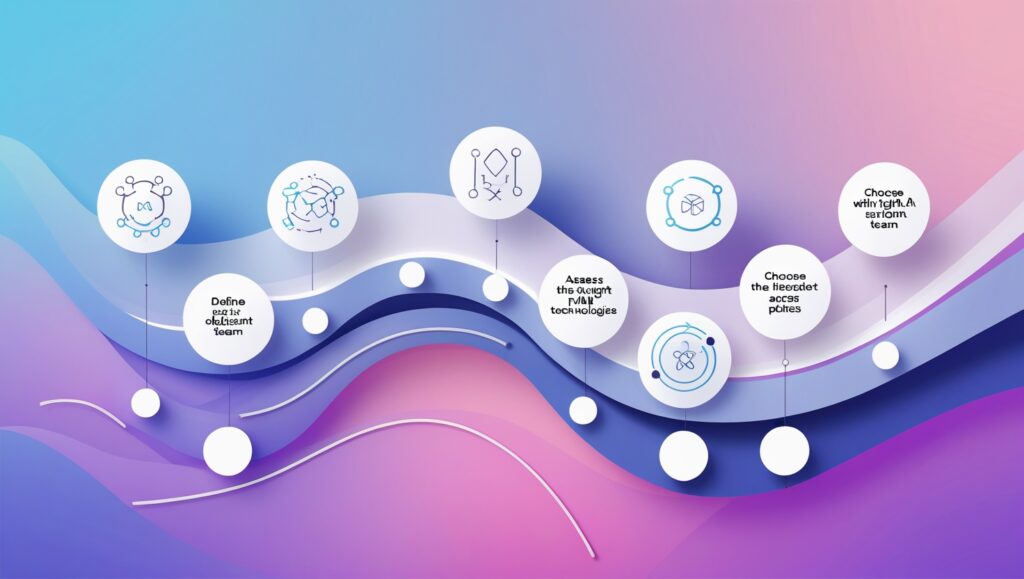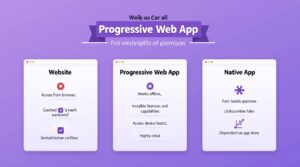click to get service View profile
Learn how to integrate AI into web or mobile app to boost efficiency, enhance user experience, and drive business growth. Discover practical strategies, tools, and real-world examples.
In today’s rapidly evolving digital landscape, businesses are constantly seeking smarter, faster, and more efficient solutions to stay ahead of the competition. One of the most transformative ways to achieve this is to integrate AI into web or mobile app experiences. From automating user interactions to offering personalized recommendations, AI is no longer a luxury—it’s a necessity for modern business growth.
In this guide, we’ll explore how you can seamlessly integrate AI into your web or mobile app, the key benefits it brings, and practical strategies to ensure your AI implementation aligns with your business goals.
What is AI Integration?
Integrating AI into web or mobile app development means embedding artificial intelligence directly into your core digital workflows to enhance efficiency, automate processes, and deliver smarter user experiences. By doing so, businesses can unlock deeper customer insights, streamline operations, and create highly personalized interactions across every stage of the user journey.
As AI technology continues to evolve, it’s transforming how businesses manage data, make decisions, and interact with customers. By integrating AI into web or mobile app solutions, organizations can process vast amounts of data, uncover patterns, and predict future trends with greater accuracy—minimizing reliance on manual tasks. This empowers businesses to respond swiftly and strategically to shifting market demands.
Benefits and Challenges of Integrating AI into Applications for Businesses

Benefits of App AI integration
As demand increases, many companies are looking for AI integration services to efficiently scale these capabilities. This brings multiple benefits, including:
- Repetitive Task Automation: AI handles routine and time-intensive tasks, freeing up employees to concentrate on higher-level strategic and creative responsibilities.
- User Experience Personalization: AI analyzes customer data to deliver personalized recommendations and interactions that enhance engagement and build stronger customer loyalty.
- Security Enhancement: AI continuously monitors systems and user behavior to detect anomalies and potential threats in real time, strengthening overall security defenses.
- Decision Making Support: AI processes large volumes of data from multiple sources, uncovers hidden patterns, and provides actionable insights that help leaders make informed decisions.
- Process Improvement: As AI systems learn over time, they offer ongoing suggestions and optimizations to refine workflows and improve customer-facing services.
Challenges of App AI integration
While the decision to integrate AI into web or mobile app solutions brings substantial benefits, businesses often face critical challenges along the way. Recognizing these obstacles early is key to crafting effective strategies, avoiding implementation pitfalls, and ensuring long-term success with AI-driven technologies.
- Legacy system constraints: Many existing IT infrastructures are outdated and incompatible with modern AI technologies, making integration complex and costly.
- Data disorganization: AI performance depends heavily on high-quality data, but scattered data across multiple platforms, inconsistent formats, and gaps in data quality create barriers to accurate analysis and reliable insights.
- Ethical concerns: Ensuring AI systems operate fairly and responsibly is critical, especially in sensitive areas like credit scoring, personalized recommendations, where biases or lack of transparency can harm customers and damage trust.
- Skill gaps and learning curves: Implementing AI requires specialized knowledge that many organizations lack internally, making training and hiring skilled talent a necessity.
- Cost and resource constraints: Integrating and maintaining AI systems demands significant investment in technology and human resources, which can be a major hurdle, especially for smaller businesses.
8 Steps to Successfully Integrating AI into business

1. Define Clear Objectives
Before you integrate AI into web or mobile app solutions, it’s essential to clearly define the purpose behind the integration. Having a well-defined objective ensures your AI efforts address real business challenges instead of simply following trends. This focus helps prevent scope creep and sets a strong foundation for successful AI implementation.
How to conduct:
- Engage stakeholders: Collaborate with leaders and department heads to identify pressing business challenges and strategic priorities.
- Frame specific use cases: Convert these challenges into well-defined AI use cases, outlining clear inputs, desired outputs, and potential solutions.
- Set measurable goals: Establish KPIs (e.g., cost reduction, time savings, accuracy improvements) to track the effectiveness and ROI of your AI efforts.
Clarifying the core problem early on is essential when you integrate AI into web or mobile app workflows. It guides smarter decisions about data collection, selecting the right AI techniques, and pinpointing where AI adds the most value. This clarity also helps demonstrate tangible benefits, making it easier to gain long-term support across the organization.
2. Build an AI-Proficient Team
Once objectives are clear, successfully integrating AI into web or mobile app projects relies on assembling the right team. A cross-functional group that combines technical expertise with business insight ensures AI solutions are both practical to implement and aligned with your company’s goals, maximizing impact.
How to conduct:
- Identify key roles: Assemble a team that includes data scientists, ML engineers, domain experts, and project managers. Each member should have a clearly defined responsibility to drive efficiency and accountability.
- Set a development plan: Outline timelines, milestones, and deliverables aligned with your AI objectives. This creates shared direction and helps manage progress across phases.
- Foster collaboration: Establish communication channels between technical and business teams. Continuous dialogue ensures the solution remains aligned with both strategic goals and user needs.
3. Assess Data Readiness
AI depends heavily on quality data — and when you integrate AI into web or mobile app solutions, messy, siloed, or inaccessible data can undermine even the most advanced models. Early assessment of data readiness is crucial to avoid project delays, ensure reliable AI performance, and build a scalable foundation for future growth.
How to conduct:
- Audit available data: Review data sources, formats, and volumes across departments. Identify inconsistencies, missing values, or unstructured data that may need transformation.
- Centralize and clean data: Consolidate siloed datasets into centralized, shareable repositories like data lakes. Apply consistent formatting, labeling, and cleansing processes to prepare for AI use.
- Set up data exchange pipelines: Use tools like open-source AI data integration platforms to enable real-time data sharing between systems. This ensures information stays synchronized and up-to-date across teams.
- Establish data governance: Define rules for access, usage, and security through formal governance policies. Continuous monitoring ensures long-term data integrity and compliance.
4. Choose the Right AI Technologies
Selecting the right AI technologies is crucial when you integrate AI into web or mobile app solutions to turn your strategy into scalable reality. Choosing an incompatible tech stack can result in security risks, costly rework, and integration challenges. Conversely, the right AI tools and agents ensure seamless integration, long-term flexibility, and faster time to value.
How to conduct:
- Evaluate deployment models: Choose between cloud-based (for scalability), on-premises (for control), or hybrid solutions based on your infrastructure and business needs.
- Ensure security and compliance: Verify that selected tools meet your industry’s data protection regulations (e.g., GDPR, HIPAA). This is especially vital when working with sensitive or personal data.
- Decide to build or buy: Assess whether your team has the technical capability to build AI solutions internally or if it’s more efficient to partner with external vendors or consultants.
5. Start with Pilot Projects
Jumping straight into full-scale AI projects can waste resources and hinder adoption. By starting small to integrate AI into web or mobile app through pilot projects, you can validate assumptions, identify technical and operational challenges, and gather real-world feedback—minimizing risks while maximizing learning.
How to conduct:
- Select a manageable use case: Start with a use case that is high in value but low in complexity. This ensures quick results and builds early momentum.
- Track success metrics: Monitor measurable KPIs such as model accuracy, processing time, or efficiency gains. This provides a clear view of what’s working and what’s not.
- Engage end users early: Involve the people who will actually use the AI solution during the pilot. Their feedback helps fine-tune usability and boost future adoption.
- Adapt based on results: Use insights from the pilot to refine your AI model, data pipelines, or workflows. Quick iteration improves effectiveness and prepares the project for scale..
6. Scale and Integrate Across the Organization
Once your pilot project proves successful, it’s time to scale and fully integrate AI into web or mobile app workflows across your business operations. This phase focuses on embedding AI into daily processes, encouraging organization-wide adoption, and avoiding isolated pockets of innovation that fail to deliver real value.
How to conduct:
- Create a scaling roadmap: Develop a clear plan detailing the timeline, teams, and processes for expanding AI solutions beyond the pilot phase.
- Train employees: Provide comprehensive training to ensure staff understand how to effectively use and collaborate with AI tools.
- Embed AI into workflows: Seamlessly integrate AI systems into daily operations to optimize efficiency and decision-making.
- Monitor enterprise KPIs: Track long-term metrics such as ROI, productivity improvements, and user satisfaction to measure sustained value.
7. Ensure Ongoing Governance and Ethics
Integrating AI into web or mobile app solutions is not a one-time project—it’s an ongoing process that demands continuous monitoring to ensure fairness, compliance, and trustworthiness. Implementing strong governance and ethical practices helps protect your organization from reputational risks, legal issues, and biased outcomes as AI models and data evolve over time.
How to conduct:
- Establish governance policies: Define clear rules for data usage, model lifecycle management, and roles accountable for AI oversight.
- Regularly audit for bias and fairness: Continuously monitor AI outputs to identify and address any unintended discriminatory effects.
- Set periodic review cycles: Schedule routine evaluations to check model accuracy, relevance, and compliance with evolving standards.
- Maintain transparency and explainability: Document decision-making processes and ensure AI results can be clearly interpreted by stakeholders.
Ongoing governance ensures your AI remains responsible, reliable, and aligned with both ethical standards and business goals.
Practical examples of AI implementation
As modern businesses strive to stay competitive, learning how to integrate AI into web or mobile app solutions has become essential for driving efficiency and fostering innovation. The following examples showcase how companies successfully implement AI to address real-world challenges and accelerate their growth.
1. Chatbots and virtual assistants
Many organizations face challenges managing high volumes of customer inquiries efficiently. By choosing to integrate AI into web or mobile app platforms, businesses can deploy AI-powered chatbots that provide scalable self-service options, allowing customers to receive instant support without waiting for human agents. Additionally, AI virtual assistants analyze requests, pull data from multiple sources, and resolve common issues—delivering a smoother, faster, and more efficient customer experience.
This approach is particularly valuable for industries looking to integrate AI into web or mobile app platforms within the banking sector. For example, a leading telecommunications provider uses AI-powered virtual assistants to offer 24/7 customer support. When a customer notices an unexpected charge late at night, the assistant can instantly respond, verify the issue, and guide them through freezing their card and filing a dispute—all seamlessly within the app
2. Product recommendation engines
AI-powered product recommendation engines play a key role in helping businesses create personalized shopping experiences. These systems examine user behavior, purchase history, and personal preferences to recommend products that align with each customer’s interests. This personalization improves customer satisfaction, increases sales, and lowers the chance that shoppers abandon their carts.
A well-known example of how to integrate AI into web or mobile app effectively is Amazon, a leader in the eCommerce industry. When a customer adds running shoes to their cart, the AI-powered system instantly suggests related items like athletic apparel or fitness trackers. These real-time recommendations ensure a personalized and relevant shopping experience throughout the customer journey.
3. Demand forecasting
By choosing to integrate AI into web or mobile app solutions, businesses can significantly improve demand forecasting. AI analyzes vast amounts of data to uncover subtle patterns and predict future demand with high accuracy. This enables better inventory management, reduces costs, and boosts overall operational efficiency.
Walmart offers a compelling example of how to integrate AI into web or mobile app systems effectively. The company utilizes AI-powered predictive tools to track sales and inventory levels across its stores. When the system detects sudden shifts in product demand, it alerts managers to adjust inventory distribution and ordering accordingly. This proactive strategy helps Walmart maintain well-stocked shelves during peak times and respond swiftly to market fluctuations.
4. Predictive maintenance
Predictive maintenance is a powerful application when you integrate AI into web or mobile app solutions, helping businesses reduce equipment downtime and lower maintenance costs. By leveraging historical and real-time data from equipment sensors, AI can accurately predict when machines might fail or need servicing. This allows companies to schedule maintenance proactively, prevent unexpected breakdowns, and extend the lifespan of their valuable assets.
In real-world applications, many manufacturing companies choose to integrate AI into web or mobile app solutions for predictive maintenance of critical machinery. When AI detects unusual patterns or early signs of wear, it promptly notifies maintenance teams to carry out targeted inspections or repairs. This proactive approach reduces downtime, prevents costly breakdowns, and ensures stable, efficient production processes.
5. Automated document analysis
One of the most valuable ways to integrate AI into web or mobile app solutions is through automating document analysis. Traditionally, reviewing and processing large volumes of paperwork has been time-consuming and labor-intensive. AI-powered document analysis tools enable businesses to rapidly extract and interpret key information from diverse document types, significantly improving efficiency and accuracy.
For instance, docAnalyzer.ai uses AI-powered chat interfaces to help users interact with documents efficiently to simplify complex workflows. The automation not only speeds up operations but also reduces errors, allowing employees to focus on more strategic work that requires creativity and critical thinking.
You may want to read more: Agentic AI vs Generative AI – Key Differences & Use Cases
Final thoughts
Successfully integrating AI into web or mobile app solutions is no longer just an option—it’s a necessity for businesses aiming to stay competitive and drive growth. By clearly defining objectives, assembling the right team, ensuring data readiness, and starting with pilot projects, companies can unlock AI’s full potential to enhance efficiency, improve user experiences, and make smarter decisions. With thoughtful planning and execution, AI integration can transform your digital products and position your business for long-term success in an ever-evolving market.

